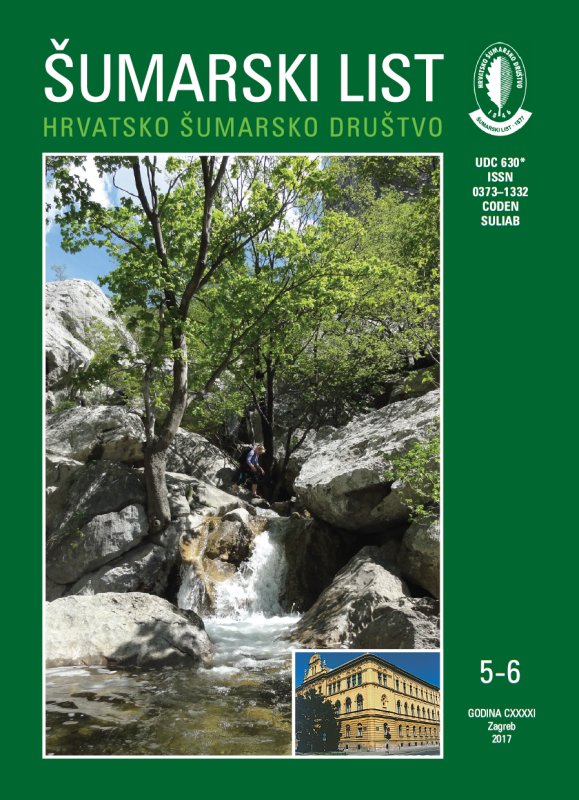
broj: 5-6/2017
pdf (25,6 MB) |
|
||||||||||||||
| RIJEČ UREDNIŠTVA | ||
| Uredništvo | ||
| REPETITIO EST MATER STUDIORUM pdf HR EN | 225 | |
| IZVORNI ZNANSTVENI ČLANCI | ||
| Damir Ugarković, Kristina Pleša | UDK 630* 114 + 228 (001) https://doi.org/10.31298/sl.141.5-6.1 | |
| COMPARISON BETWEEN TREE DIEBACK OF PEDUNCULATE OAK AND NARROW-LEAVED ASH IN RELATION TO ECOLOGICAL CONSTITUTION OF SPECIES pdf HR EN | 227 | |
| Summary The pedunculate oak (Quercus robur L.) and narrow-leaved ash (Fraxinus angustifolia Vahl) tree dieback phenomenon presents an economic as well as ecologic problem. Factors that cause tree dieback can be biotic, biotopic (within habitat) and structural (within stand). In managed forests, the volume of dead trees or volume of trees cut in a sanitation harvests are most often used to show the intensity of tree dieback, and may also be used as an indicator of the stands condition (Capecki, 1981).Every species has its own ecological niche. Forest tree species have varying reactions to changes in environmental factors, to stress and ultimately to dying. The study was conducted in „Zelenika” management unit in Posavina. The aims of the study were to establish pedunculate oak and narrow-leaved ash tree dieback dynamics, to research the influence of biotopic and structural factors on dieback intensity and to compare dieback intensities according to the stand age class and microrelief. For analysis were climatic data for Novska meteorological station, water level data of Novska watercourse, and groundwater level data from „Zelenika” piezometric station were used. Dry years and dry periods, and wet years and wet periods, were determined using the percentile method and the Walter climate diagrams. Growing volume of withered pedunculate oak and ash trees, as well as structural factors data(stand structure elements) were collected from the O-2 form of the Forest management plan. Dieback intensities were calculated on the basis of growing volume of the withered trees per area unit ratio. The intensity of tree death was shown in absolute numbers, as m3/ha (Siwecki et al. 1998). Considering the average change rate, dieback intensities of pedunculate oak and narrow-leaved ash tree are increasing. The highest dieback intensities for both forest species were found in the VI age class (Figure 2). On the basis of the conducted research, it can be concluded that climatic, hydrological and structural factors influence pedunculate oak and narrow-leaved ash tree dieback. Pedunculate oak is more sensitive to climatic elements in comparison to narrow-leaved ash tree. Frequent dry years significantly affected the dying of these two species, which can both be considered hydrophytes in terms of their ecological demand for water. The results of this study showed that narrow-leaved ash was more vulnerable to drought than pedunculate oak. Drought and rain periods also significantly influence tree dieback (table 5). The effect of dry periods on the dieback of these two species was greater in relation to the lack of wet periods in these lowland forests. The decrease of mid and minimal water levels of watercourse influenced pedunculate oak dieback, while a decrease of maximum watercourse water levels influenced narrow-leaved ash tree dieback (table 6). Groundwater level decrease in deeper layers of pedosphere had asignificant influence on tree dieback intensities (table 7). It was revealed that all structural factors influence pedunculate oak dieback, while narrow-leaved ash tree dieback was influenced only by stocking and tree number increase in a stand (table 8).The dieback of pedunculate oak was higher in older stands. No correlation was detected between the dieback of narrow-leafed ash and stand age. Key words: pedunculate oak; narrow-leaved ash tree; dieback; biotopic factors; structural factors | ||
| Ivan Perković, Nikola Pernar, Darko Bakšić, Nikola Glamočlija, Vibor Roje | UDK 630* 114 (001) https://doi.org/10.31298/sl.141.5-6.2 | |
| THE EFFECT OF PARENT MATERIAL ON PHYSICAL AND MINERAL SOIL PROPERTIES ON MEDVEDNICA NATURE PARK pdf HR EN | 237 | |
| Nera Bakšić, Darko Bakšić | UDK 630* 262+114.2 (001) https://doi.org/10.31298/sl.141.5-6.3 | |
| FOREST FLOOR FUEL LOADS AND CARBON STOCKS IN ALEPPO PINE FORESTS ON ISLAND OF MLJET pdf HR EN | 247 | |
| Zeynep Yavuz, Mustafa Yilmaz | UDK 630 + 232.3 (001) https://doi.org/10.31298/sl.141.5-6.4 | |
| SEED DORMANCY AND CONE AND SEED MORPHOLOGY OF SYRIAN JUNIPER (Juniperus drupacea Labill.) IN THE EASTERN MEDITERRANEAN REGION OF TURKEY pdf HR EN | 257 | |
| PRETHODNO PRIOPĆENJE | ||
| Ivica Tikvić, Damir Ugarković, Željko Zečić, Patrik Korijan, Davor Gašpar | UDK 630* 89 https://doi.org/10.31298/sl.141.5-6.5 | |
| Truffles in Croatia: natural distribution and ecological problems pdf HR EN | 263 | |
| Nediljko Landeka, Martina Podnar | UDK 630* 453 https://doi.org/10.31298/sl.141.5-6.6 | |
| RECORD OF ALIEN Cinara (Cinara) cedri, (HEMIPTERA; APHIDIDAE) IN ISTRIA, CROATIA pdf HR EN | 271 | |
| PREGLEDNI ČLANCI | ||
| Tikvić, Ugarković, Peles, Knežić, Medunić-Orlić, Marinić, Butorac, Čmrlec, Koharević, Nazlić, Pavlinović, Špika, Tomić | UDK 630* 272 + 901 https://doi.org/10.31298/sl.141.5-6.7 | |
| ASSESSMENT OF FOREST ECOSYSTEM SERVICES AND NON-MARKET FOREST FUNCTIONS IN PARK FOREST MARJAN SPLIT pdf HR EN | 277 | |


